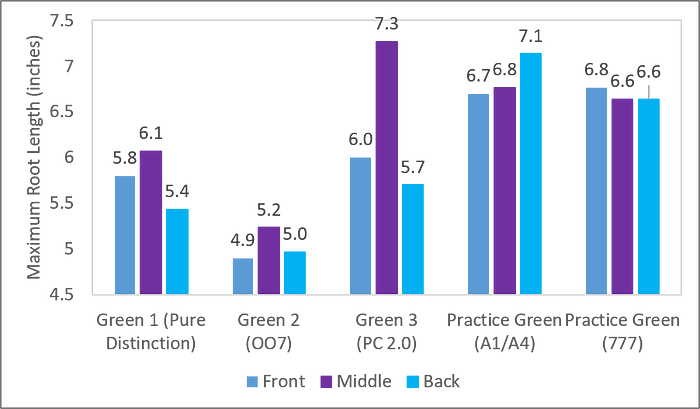Wet Again! Brown Patch, Dollar Spot, 1st Melting Out, TED Turf Education Day, Green Research
Thunderstorms would appear and then reappear. Large precipitation totals occurred on Monday and Thursday in northern Illinois. Comparatively, our situation this week is insignificant given conditions in other parts of the United States (storms in the Pacific Ocean played a major role in historic fires and loss of life). In the upper Midwest, a dry August period seems to have ended. Though summer isn’t over yet. August often means tired plants (wear) will definitely have a hard life. It helps to explain a few new aspects from lawns to fairways. The new foliar diseases we’ve begun to see — rusts and leaf spots — are, in part, due to compromised plant defenses. Any reduced root biomass means less stored energy (Plant Physiology 101).

In the landscape, most annual flowers are now peaking. Whether in the ground (landscape beds) or in a container (pots), massive amounts of blooms are now at hand. On golf courses, conditions continue to remain much better than expected. Our latest deluge of wet weather was met with dry soil conditions and thus well received. If this summer indeed ends on a wet note our undivided attention will be on roots. Here’s why. High traffic areas are vulnerable to wet, compact soils. This creates a greater incidence of root rots unless dealt with culturally (poking holes via aerification) and/or preventatively (fungicides are applied, then immediately watered in to depth of roots). Dense, healthy grass in August means one thing — roots!
Weather



Brown Patch, Rhizoctonia solani
Update on research that uses a creeping bentgrass tee at North Shore Country Club in Glenview.
Quick Points
- Change. Summer conditions that were conducive (nights in the upper 60s and a leaf wetness duration of 10 hours or more) are now changing.
- Leaf Wetness. Ample leaf wetness continues to exist, 10 hours or more.
- Temperature. Cooler nights (easing away from 65-70 degrees) are now limiting brown patch development.
- Ajuvants. Testing SYNC® by Precision Laboratories (Kenosha, WI) for any additional ability to improve fungicide efficacy. Current data shown without final statistical analysis.


Dollar Spot, Clarireedia jacksonii
Update on research that uses a creeping bentgrass tee at North Shore Country Club in Glenview.
Quick Points
- Disease Progression. Conditions generally remain conducive for rapid dollar spot development in Chicago from August through September. Nighttime lows in the 50s ends dollar spot epidemics (October).
- Temperature. Favored by air temperatures ranging from 60–90 degrees (optimum 70–80 degrees).
- Ajuvants. Testing SYNC® by Precision Laboratories (Kenosha, WI) for any additional ability to improve fungicide efficacy. Current data shown without final statistical analysis.


First Report of Melting Out of Kentucky Bluegrass, Pyrenophora spp.
Note: New Latin name is used to describe a complex of leaf spot fungi (Drechslera refers to the asexual stage of Pyrenophora).
One more sign of fall you ask? Melting out of Kentucky bluegrass roughs has begun in Chicago. I scouted the usual areas on Sunshine Course in Lemont and found it for the first time this week. A problem on older Kentucky bluegrass varieties without genetic resistance. Newer Kentucky bluegrass cultivars have been selected for resistance to this disease.
Symptoms
Initially small flecks appear. They grow into spots that elongate parallel to a leaf blade axis. Over time more appear and coalesce. It can progress to a point of severe thinning. How “melting out” gets its name.
Control
Best control starts at establishment. Use newer varieties of Kentucky bluegrass.
For more information see the National Turfgrass Evaluation Program website and look for a test site nearest your location. Please see below.



Reference
Compendium of Turfgrass Diseases — Fourth Edition. 2023. Tredway, Tomaso-Peterson, Kerns, and Clarke, editors
Illinois Landscape Contractors Association (ILCA) Turf Education Day (TED) Thu, Sep 21, 2023
See below and Click Here for more information and to register.

Green Research — August 15, 2023 by Shehbaz Singh, MS
As a part of monthly evaluation of greens, fairways, and tees at Bob Berry Sunshine Course, all greens were evaluated last week.
Background
All are creeping bentgrass. Greens 1, 2 and 3 are around 5,300 sq ft each. The practice green is about 7,811 sq ft. As a part of renovation project, the grass on green 1 to 3 was killed, uppermost mat layer was scrapped off and then were reseeded to newer creeping bentgrass varieties. The practice green was completely reconstructed as a variable depth green and then reseeded (see above). All work was conducted by Wadsworth Golf Construction Co.
Green 1. Pure Distinction
Green 2. OO7
Green 3. PC 2.0
Practice Green. Penn A1 plus Penn A4 (half of green) & 777 (half of green)
Evaluation procedure. On each green, three points were selected in a systematic way (straight center line in front, middle, and back). Three data readings or samples were collected around each of the three marked points. Five sets (five greens) of data were collected.
- Visual Quality (1–9 scale with 9 best and 6 = minimum acceptable)
- Normalized Difference Vegetation Index (NDVI) using GreenSeeker by Trimble
- Soil Moisture using TDR350 by Spectrum Technologies
- Surface Firmness using Field Scout TruFirm by Spectrum Technologies
- Shear Strength using Shear Strength Tester by Turf-tech International Inc., Florida.
· Root Length was measured taking the average of four 0.5-inch diameter soil core samples (maximum root length)
- Root-Feeding Nematodes were extracted by lite sucrose extraction with centrifugation using 100g soil (upper 2-inches of four soil cores). Four samples were collected around the point for each green area.
- Ball roll was measured using USGA stimpmeter for front, middle, and back section of each green.












Final Photo

